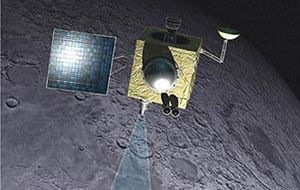MercoPress. South Atlantic News Agency
Water molecules confirmed in the moon’s polar region surface
 India’s Chandrayaan-I spacecraft plays leading role in the lunar mission
India’s Chandrayaan-I spacecraft plays leading role in the lunar mission US space agency NASA said India’s maiden lunar mission had confirmed the presence of water molecules in the polar region of moon’s surface. Indian Space Research Organisation’s. ISRO, chairman G Madhavan Nair called the finding “path breaking”.
NASA said data from its Moon Mineralogy Mapper, or M3, one of the 11 payloads aboard the Chandrayaan-I spacecraft, had revealed water molecules in “amounts that are greater than predicted, but still relatively small”. It said the instrument had also found traces of hydroxyl, a molecule containing one oxygen atom and one hydrogen atom, in the lunar soil.
“Water ice on the moon has been something of a holy grail for lunar scientists for a very long time,” said Jim Green, director of the Planetary Science Division at NASA Headquarters in Washington. “This surprising finding has come about through the ingenuity, perseverance and international cooperation between NASA and the India Space Research Organisation”.
The Chandrayaan-I mission, launched in October last year, had to be aborted last month, more than a year before its scheduled two-year life-term, due to technical glitches. ISRO claimed that about 95% of the scientific objectives of Chandrayaan-I had been achieved.
The data from the M3 instrument have been found to be in close agreement with those sent by the Visual and Infrared Mapping Spectrometer (VIMS) aboard NASA’s own Cassini spacecraft that flew by the moon in 1999. A High-Resolution Infrared Imaging Spectrometer on NASA’s Epoxi spacecraft, which flew past the moon in June this year on way to a November 2010 date with comet Hartley 2, also confirmed the finding, the NASA statement said. The findings have been published in the latest issue of the journal Science.
The M3 team found water molecules and hydroxyl at diverse areas of the sunlit region of the moon’s surface, but the water signature appeared stronger at the moon’s higher latitudes.
“We see both water and hydroxyl. While the abundances are not precisely known, as much as 1,000 water molecule parts-per-million could be in the lunar soil. To put that into perspective, if you harvested one ton of the top layer of the moon’s surface, you could get as much as 32 ounces of water,” said Roger Clark, a US Geological Survey scientist in Denver and a member of both the VIMS and M3 teams.
Data from M3 was studied by scientists from the Brown University in the US. Carle Pieters, professor of geology at Brown University and principal investigator attached to the M3, praised ISRO for facilitating the finding.
“If it weren’t for them, we wouldn’t have been able to make this discovery,” she was quoted as saying in a Brown University release.
“We’ve made a very important step with this discovery, and now there are some very important steps to follow up on,” Pieters said.
“When we say water on the moon, we are not talking about lakes, oceans or even puddles. Water on the moon means molecules of water and hydroxyl that interact with molecules of rock and dust specifically in the top millimetres of the moon’s surface,” Peters said.
The water on the moon, according to scientists, does not remain but comes and goes each lunar day.




Top Comments
Disclaimer & comment rulesCommenting for this story is now closed.
If you have a Facebook account, become a fan and comment on our Facebook Page!